
© 3M 2019
USER INSTRUCTIONS
5903620 Rev. C
FLEXIGUARD™
Counterweight Trailer
Fall Arrest System
1
8530690
OSHA 1926.502 OSHA 1910.140
Page is loading ...
Page is loading ...
Page is loading ...
Page is loading ...
Page is loading ...
Page is loading ...
Page is loading ...
Page is loading ...
Page is loading ...

FORM NO: 5908278 REV: A
11
SAFETY INFORMATION
Please read, understand, and follow all safety information contained in these instructions prior to the use of this Flexiguard System.
FAILURE TO DO SO COULD RESULT IN SERIOUS INJURY OR DEATH.
These instructions must be provided to the user of this equipment. Retain these instructions for future reference.
Intended Use:
This Flexiguard System is intended for use as part of a complete fall protection or rescue system.
Use in any other application including, but not limited to, material handling, recreational or sports related activities, or other activities not described in
the User Instructions, is not approved by 3M and could result in serious injury or death.
This system is only to be used by trained users in workplace applications.
! WARNING
This Flexiguard System is part of a personal fall protection or rescue system. It is expected that all users be fully trained in the safe installation and
operation of the complete system. Misuse of this system could result in serious injury or death. For proper selection, operation, installation,
maintenance, and service, refer to all Product Instructions and all manufacturer recommendations, see your supervisor, or contact 3M Technical Service.
• To reduce the risks associated with transporting a Flexiguard system which, if not avoided, could result in serious injury or death:
- Ensure the system is properly secured or congured prior to transport. Refer to the User Instructions for detailed transportation requirements.
- Only transport below 5 mph (8 km/h) and at inclines of 10° or less, or as outlined in the User Instructions.
- Ensure the system will not contact overhead objects or electrical hazards while transporting or in use.
• To reduce the risks associated with working with a Flexiguard system which, if not avoided, could result in serious injury or death:
- Inspect all components of the system before each use, at least annually, and after any fall event, in accordance with the User Instructions.
- If inspection reveals an unsafe or defective condition, remove the system from service and repair or replace according to the User Instructions.
- Any system that has been subject to fall arrest or impact force must be immediately removed from service. Refer to the User Instructions or
contact 3M Fall Protection.
- The substrate or structure on which the system is attached/positioned must be able to sustain the static loads specied for the system in the
orientations permitted in the User Instructions or Installation Instructions.
- Do not exceed the number of allowable users as per the User Instructions.
- Never attach to a system until it is fully assembled, positioned, adjusted, and installed. Do not adjust the system while a user is attached.
- Never work outside the safe work area as dened by the User Instructions.
- Do not connect to the system while it is being transported or installed.
- Always maintain 100% tie-off when transferring between anchor points on the system.
- Use caution when installing, using, and moving the system as moving parts may create potential pinch points.
- Ensure proper lockout/tagout procedures have been followed when applicable.
- Only connect fall protection subsystems to the designated anchorage connection point on the system.
- When drilling holes for assembly or installation of the system, ensure no electric lines, gas lines, or other critical materials or equipment will be
contacted by the drill.
- Ensure that fall protection systems/subsystems assembled from components made by different manufacturers are compatible and meet the
requirements of applicable standards, including the ANSI Z359 or other applicable fall protection codes, standards, or requirements. Always
consult a Competent or Qualied Person before using these systems.
• To reduce the risks associated with working at heights which, if not avoided, could result in serious injury or death:
- Ensure your health and physical condition allow you to safely withstand all of the forces associated with working at height. Consult with your
doctor if you have any questions regarding your ability to use this equipment.
- Never exceed allowable capacity of your fall protection equipment.
- Never exceed maximum free fall distance of your fall protection equipment.
- Do not use any fall protection equipment that fails pre-use or other scheduled inspections, or if you have concerns about the use or suitability
of the equipment for your application. Contact 3M Technical Services with any questions.
- Some subsystem and component combinations may interfere with the operation of this equipment. Only use compatible connections. Consult
3M prior to using this equipment in combination with components or subsystems other than those described in the User Instructions.
- Use extra precautions when working around moving machinery (e.g. top drive of oil rigs) electrical hazards, extreme temperatures, chemical
hazards, explosive or toxic gases, sharp edges, or below overhead materials that could fall onto you or the fall protection equipment.
- Use Arc Flash or Hot Works devices when working in high heat environments.
- Avoid surfaces and objects that can damage the user or equipment.
- Ensure there is adequate fall clearance when working at height.
- Never modify or alter your fall protection equipment. Only 3M or parties authorized in by 3M may make repairs to the equipment.
- Prior to use of fall protection equipment, ensure a rescue plan is in place which allows for prompt rescue if a fall incident occurs.
- If a fall incident occurs, immediately seek medical attention for the fallen worker for the worker who has fallen.
- Do not use a body belt for fall arrest applications. Use only a Full Body Harness.
- Minimize swing falls by working as directly below the anchorage point as possible.
- If training with this device, a secondary fall protection system must be utilized in a manner that does not expose the trainee to an unintended
fall hazard.
- Always wear appropriate personal protective equipment when installing, using, or inspecting the device/system.
EN

12
;
Prior to installation and use of this equipment, record the product identication information from the ID label in the
Inspection and Maintenance Log (Table 2) at the back of this manual.
;
Highway Usage Restriction: The Flexiguard™ Counterweight Trailer Fall Arrest System is not approved for on-highway use.
The Flexiguard™ Counterweight Trailer Fall Arrest System is rated for off-road use only. 3M does not supply a trailer title with
the Flexiguard™ Counterweight Trailer Fall Arrest System.
PRODUCT DESCRIPTION:
Figure 1 illustrates the Flexiguard
™
Counterweight Trailer Fall Arrest System. The Counterweight Trailer Fall Arrest System is a
vehicle towed fall protection system with overhead anchorage connections for two people. It is intended for use as an anchorage
in a Personal Fall Arrest System (PFAS).
Figure 2 illustrates components of the Counterweight Trailer. See Table 1 for Component Specications. The system is
comprised of two Boom Arms (A) with Anchorage Connection Points (B) mounted on an Adjustable Mast (C) extending from a
Counterweighted Trailer (D). The base of the Adjustable Mast has a Hand Crank Chain Drive (E) to adjust the height of the Mast.
The Counterweighted Trailer is equipped with a Lunette (Pintle) Ring (F) or Ball Coupler for towing behind a vehicle with an SAE
Class 4 Hitch. Leveling Jacks (G) and a Tongue Jack (H) are used with an onboard Slope Indicator (I) to stabilize and level the
system.
Table 1 – Specications
System Specications:
Capacity: One Self-Retracting Device (SRD) per each Boom Arm Shock Absorbing Anchorage Point.
1 Person per SRD with a combined weight (clothing, tools, etc.) less than or equal to 310 lbs (140 kg).
Tow Vehicle: The Tow Vehicle and Hitch Receiver must be properly equipped to handle the System Specications (System Weight, Tongue
Weight, etc.).
Anchorage: Structure supporting the Counterweight Trailer Fall Arrest System must withstand a 9,100 lb (40.5 kN) vertical load.
Anchor Height: Adjustable Mast allows for 12.75 ft–20.5 ft (3.88 m–6.25 m) Anchor Height.
Offset: 3.9 ft (1.19 m)
Total System
Weight:
Approximately 5,500 lb (2,495 kg) with Concrete
System Tongue
Weight
Approximately 550 lb (250 kg)
Component Specications:
Figure 2
Reference Component Materials Note:
A
Head Assembly and Boom Arms Steel Maximum Capacity: 1 person up to 310 lbs
(140 kg) including clothes, tools, etc. per Boom
Arm and Anchorage Connection Point
B
Anchorage Connection Points Alloy Steel
C
Adjustable Mast Aluminum and Steel
D
Counterweighted Trailer Frame - Steel
Drawbar - Steel
Counterweight - 0.75 yds of
4,000 psi Concrete
Dry Trailer Weight: 1,197 lb (542.95 kg)
Dry Tongue Weight: 154 lb (69.85 kg)
Weight with Concrete: 4,097 lb (1,858.37 kg)
Electrical System: 12 Volt
Counterweight: 2,900 lb (1,315.42 kg)
E
Hand Crank Chain Drive Crank - Steel
Base - Aluminum
Chain Cover - Steel
Chain - Steel
Gears - Steel
F
Lunette (Pintle) Ring or Ball Coupler
G
Leveling Jack Steel
H
Tongue Jack Steel
I
Slope Indicator Plastic
1 Anchorage Connection Points: Each Anchorage Connection Point has been tested and veried to a safety factor of 2:1 per OSHA.

13
1.0 PRODUCT APPLICATION
1.1 PURPOSE: Flexiguard
™
Anchorage Systems are designed to provide anchorage connection points for a Personal Fall Arrest
System (PFAS).
1.2 SUPERVISION: Installation of this equipment must be supervised by a Qualied Person
1
. Use of this equipment must be
supervised by a Qualied Person
1
.
1.3 TRAINING: This equipment must be installed and used by persons trained in its correct application. This manual is to be
used as part of an employee training program as required by OSHA. It is the responsibility of the users and installers of
this equipment to ensure they are familiar with these instructions, trained in the correct care and use of this equipment,
and are aware of the operating characteristics, application limitations, and consequences of improper use of this
equipment.
1.4 RESCUE PLAN: When using this equipment and connecting subsystem(s), the employer must have a rescue plan and
the means at hand to implement and communicate that plan to users, authorized persons
2
, and rescuers
3
. A trained, on-
site rescue team is recommended. Team members should be provided with the equipment and techniques to perform a
successful rescue. Training should be provided on a periodic basis to ensure rescuer prociency.
1.5 INSPECTION FREQUENCY:
The Flexiguard
Anchorage System
shall be inspected by the user before each use and,
additionally, by a competent person other than the user at intervals of no longer than one year.
4
Inspection procedures are
described in the “Inspection and Maintenance Log”. Results of each Competent Person inspection should be recorded on
copies of the “Inspection and Maintenance Log”.
1.6 AFTER A FALL: If the Flexiguard Anchorage System is subjected to the forces of arresting a fall, it must be removed from
the eld of service immediately and replaced or inspected by an Authorized 3M Representative.
2.0 SYSTEM CONSIDERATIONS
2.1 ANCHORAGE: Structure on which the Flexiguard Anchorage System is placed or mounted must meet the Anchorage
specications dened in Table 1.
2.2 PERSONAL FALL ARREST SYSTEM: Figure 1 illustrates the application of this Flexiguard Anchorage System. Personal
Fall Arrest Systems (PFAS) used with the system must meet applicable OSHA, ANSI, state, and federal requirements. The
PFAS shall incorporate a Full Body Harness and Self-Retracting Device (SRD) with a 1,350 lb (6 kN) Maximum Arresting
Force.
2.3 FALL PATH AND SRD LOCKING SPEED: A clear path is required to assure positive locking of an SRD. Situations which
do not allow for an unobstructed fall path should be avoided. Working in confined or cramped spaces may not allow the
body to reach sufficient speed to cause the SRD to lock if a fall occurs. Working on slowly shifting material, such as sand
or grain, may not allow enough speed buildup to cause the SRD to lock.
2.4 HAZARDS: Use of this equipment in areas with environmental hazards may require additional precautions to prevent
injury to the user or damage to the equipment. Hazards may include, but are not limited to: heat, chemicals, corrosive
environments, high voltage power lines, explosive or toxic gases, moving machinery, sharp edges, or overhead materials
that may fall and contact the user or Personal Fall Arrest System.
2.5 FALL CLEARANCE: There must be sufcient clearance below the user to arrest a fall before the user strikes the ground
or other obstruction. Fall Clearance is dependent on the following factors:
• Deceleration Distance • Worker Height • Elevation of Anchorage Connector
• Free Fall Distance • Movement of Harness Attachment Element • Connecting Subsystem Length
See the Personal Fall Arrest System manufacturer’s instructions for specics regarding Fall Clearance calculation.
2.6 SWING FALLS: Swing Falls occur when the anchorage point is not directly above the point where a fall occurs (see Figure
3). The force of striking an object in a swing fall may cause serious injury or death. Minimize swing falls by working as
directly below the anchorage point as possible. Do not permit a swing fall if injury could occur. Swing falls will signicantly
increase the clearance required when a Self-Retracting Device or other variable length connecting subsystem is used.
2.7 SHARP EDGES: Avoid working where Lifeline or Lanyard components of the Personal Fall Arrest System (PFAS) can
contact or abrade against unprotected sharp edges (see Figure 4). Where contact with a sharp edge is unavoidable, cover
the edge with protective material (A).
2.8 COMPONENT COMPATIBILITY: 3M equipment is designed for use with 3M approved components and subsystems
only. Substitutions or replacements made with non-approved components or subsystems may jeopardize compatibility of
equipment and may effect the safety and reliability of the complete system.
1 Qualied Person: A person with a recognized degree of professional certicate and with extensive knowledge, training, and experience in the fall protection
and rescue eld who is capable of designing, analyzing, evaluating, and specifying fall protections and rescue systems to the extent required by OSHA and other ap-
plicable standards.
2 Authorized Person: For purposes of the Z359 standards, a person assigned by the employer to perform duties at a location where the person will be exposed
to a fall hazard.
3 Rescuer: Person or persons other than the rescue subject acting to perform an assisted rescue by operation of a rescue system.
4 Inspection Frequency: Extreme working conditions (harsh environments, prolonged use, etc.)may require increasing the frequency of competent person
inspections.

14
2.9 CONNECTOR COMPATIBILITY: Connectors are considered to be compatible with connecting elements when they
have been designed to work together in such a way that their sizes and shapes do not cause their gate mechanisms to
inadvertently open regardless of how they become oriented. Contact 3M if you have any questions about compatibility.
Connectors (hooks, carabiners, and D-rings) must be capable of supporting at least 5,000 lbs (22.2 kN). Connectors
must be compatible with the anchorage or other system components. Do not use equipment that is not compatible.
Non-compatible connectors may unintentionally disengage (see Figure 5). Connectors must be compatible in size, shape,
and strength. If the connecting element to which a snap hook or carabiner attaches is undersized or irregular in shape, a
situation could occur where the connecting element applies a force to the gate of the snap hook or carabiner (A). This force
may cause the gate to open (B), allowing the snap hook or carabiner to disengage from the connecting point (C).
Self-locking snap hooks and carabiners are required by ANSI Z359 and OSHA.
2.10 MAKING CONNECTIONS: Snap hooks and carabiners used with this equipment must be self-locking. Ensure all
connections are compatible in size, shape and strength. Do not use equipment that is not compatible. Ensure all
connectors are fully closed and locked.
3M connectors (snap hooks and carabiners) are designed to be used only as specied in each product’s user’s instructions.
See Figure 6 for examples of inappropriate connections. Do not connect snap hooks and carabiners:
A. To a D-ring to which another connector is attached.
B. In a manner that would result in a load on the gate. Large throat snap hooks should not be connected to standard
size D-rings or similar objects which will result in a load on the gate if the hook or D-ring twists or rotates, unless
the snap hook is equipped with a 3,600 lbs (16 kN) gate. Check the marking on your snap hook to verify that it is
appropriate for your application.
C. In a false engagement, where features that protrude from the snap hook or carabiner catch on the anchor, and
without visual conrmation seems to be fully engaged to the anchor point.
D. To each other.
E. Directly to webbing or rope lanyard or tie-back (unless the manufacturer’s instructions for both the lanyard and
connector specically allows such a connection).
F. To any object which is shaped or dimensioned such that the snap hook or carabiner will not close and lock, or that
roll-out could occur.
G. In a manner that does not allow the connector to align properly while under load.

15
3.0 INSTALLATION
;
Installation of the Flexiguard™ Counterweight Trailer Fall Arrest System (FAS) must be supervised by a Qualied
Person. The installation must be certied by a Qualied Person as meeting the criteria for a Certied Anchorage, or that
it is capable of supporting the potential forces that could be encountered during a fall.
1
;
This system is designed to be used on level ground only. If you have any questions regarding the safe terrain for
system installation and operation, please contact 3M.
3.1 PLANNING: Plan your fall protection system prior to installation of the Counterweight Trailer Fall Arrest System (FAS).
Account for all factors that may affect your safety before, during, and after a fall. Consider all requirements, limitations,
and specications dened in Section 2 and Table 1.
3.2 ASSEMBLY: Figure 7 illustrates assembly of the Counterweight Trailer. To assemble the system:
1. Attach the Head Assembly to the Mast: Secure the Head Assembly to the top of the Mast with 1/2” fasteners.
Torque fasteners to 90 ft-lbs (122 Nm).
2. Secure the Mast on the Counterweight Trailer: Bolt the Mast to the Counterweight Trailer with the provided 1/2”
fasteners. Torque fasteners to 90 ft-lbs (122 Nm). The Lifting Bolt on the Mast Pulley Assembly can be used to lift and
position the Mast with a forklift or similar equipment.
3. Install the Drive Extension and Pedestal: Secure the Pedestal to the Counterweight Trailer with the provided 1/2”
fasteners. Insert the Drive Extension through the Bearing and secure in place with the Crank Handle and included
3/8” fasteners. Secure the other end of the Drive extension to the Drive Shaft with the provided 3/8” fasteners.
3.3 TRANSPORT: Figure 8 illustrates transport of the Counterweight Trailer Fall Arrest System (FAS) with the tow vehicle.
Follow these procedures to hitch the Counterweight Trailer FAS to the tow vehicle and transport to the work site:
;
COUNTERWEIGHT REQUIRED: Never transport or operate the Counterweight Trailer FAS without the
Counterweight Box completely lled with concrete.
1. Hitch the system to the Tow Vehicle: Hitch the Counterweight Trailer FAS to a tow vehicle with an adequately
sized Hitch Receiver:
A. Couple the Pintle Hitch on the Tow Vehicle to the Lunette Ring on the Trailer. If needed, adjust the height of the
Lunette Ring by repositioning the Lunette Ring in the Channel Bracket on the Trailer Tongue.
B. Connect the Safety Chains.
C. Plug in the Trailer Lights.
2. Prepare the system for transport: The Counterweight Trailer FAS should be congured as follows for transport:
A. Pull down the Release Cord and secure the Ball Stop under the Catch to release the Mast Lock. Fully lower the
Adjustable Mast with the Hand Crank Chain Drive. Rotate the Hand Crank slightly further to snug the chains, but
do not over-rotate. Release the Ball Stop from the Catch and wind the excess Release Cord around the Cleat at
the base of the Mast.
B. Fully raise the Leveling Jacks and Tongue Jack. For long distance transport: unpin the Leveling Jacks, and repin
them, parallel with the trailer bumper, to the inside couplings.
3. Transport the system: Transport the Counterweight Trailer FAS to the job site. Avoid bumps, potholes, etc. which
can jar and damage components.
;
This system can be transported on moderate inclines. Proceed with extreme caution to minimize tipping.
4.0 USE
;
This system is designed to be used on level ground only. If you have any questions regarding if your terrain is safe
for system use, please contact 3M.
4.1 BEFORE EACH USE: Verify that your work area and Personal Fall Arrest System (PFAS) meet all criteria dened in
Section 2 and a formal Rescue Plan is in place. Inspect the Counterweight Trailer FAS per the ‘User’ inspection points
dened on the “Inspection and Maintenance Log” (Table 2). If inspection reveals an unsafe or defective condition, do not
use the system. Remove the system from service and contact 3M regarding replacement or repair.
;
SAFE WORK AREA: Figure 3 illustrates the Safe Work Area for the Fall Arrest System. Try to work directly below
the Anchorage Connection Point to minimize Swing Fall. The angle of the Self-Retracting Lifeline should never be more
than 30° from vertical and the Horizontal Distance between the anchorage connection point and the worker should not
be greater than 6 ft (1.82 m).

16
4.2 SYSTEM SETUP: Figure 9 illustrates setup of the Counterweight Trailer FAS:
1. Park the system perpendicular to the intended work area on a level surface. If the Tow Vehicle will remain hitched
to the system during use, engage the Parking Brake and Lock-Out/Tag-Out the vehicle to ensure it is not moved
while the system is in use. If the Tow Vehicle will not remain hitched to the system, chock the wheels on the
Counterweighted Trailer to prevent the trailer from rolling while in use.
2. Unpin the Leveling Jacks, and repin them, perpendicular to the trailer bumper, on the outside couplings.
;
On soft or unstable terrain, Jack Pads or similar material should be used under the Leveling Jacks to help
disperse the weight on the jacks.
3. Hang the Self-Retracting Devices (SRD) from the Shock Absorbing Anchorage Points.
4. Pull down the Release Cord and disengage the Ball Stop from the Catch to engage the Mast Lock. Raise the
Adjustable Mast with the Hand Crank Chain Drive. Rotate the Hand Crank slightly further to snug the chains, but do
not over-rotate.
;
Do not continue to crank the Chain Drive when the Mast is fully extended. Overextension of the Mast can
damage the Hand Crank Chain Drive and associated adjustment equipment.
5. Adjust the Leveling Jacks and Tongue Jack until the Slope Indicator reads within 1° of level.
4.3 FALL ARREST CONNECTIONS: Figure 10 illustrates use of the Counterweight Trailer FAS and its Fall Arrest Connections.
The Counterweight Trailer must always be used with a Full Body Harness and Self-Retracting Devices (SRDs). Each Boom
Arm is equipped with an Anchorage Connection Point. An SRD is installed on each Anchorage Connection Point. Connect
the other end of the SRD to the back Dorsal D-Ring on the Harness.
;
No more than one person, meeting the Capacity requirements specied in Table 1, shall be attached to each
Anchorage Connection Point.
5.0 INSPECTION
5.1 INSPECTION FREQUENCY: The Flexiguard
Fall Arrest System must be inspected at the intervals dened in Section 1.
Inspection procedures are described in the “Inspection and Maintenance Log” (Table 2). Inspect all other components of
the Fall Protection System per the frequencies and procedures dened in the manufacturer’s instructions.
;
Some Flexiguard Fall Arrest Systems are equipped with a Radio Frequency Identication (RFID) Tag. The RFID Tag
can be used in conjunction with a Handheld Reading Device to simplify inspection and inventory control and provide
records for your fall protection equipment.
5.2 DEFECTS: If inspection reveals an unsafe or defective condition, remove the Fall Arrest System from service immediately
and contact 3M regarding replacement or repair. Do not attempt to repair the Fall Arrest System.
;
Only 3M or parties authorized in writing by 3M may make repairs to this equipment.
5.3 PRODUCT LIFE: The functional life of the Fall Arrest System is determined by work conditions and maintenance. As long
as the product passes inspection criteria, it may remain in service.
6.0 MAINTENANCE, SERVICING, STORAGE
6.1 CLEANING: Periodically clean the Fall Arrest System’s metal components with a soft brush, warm water, and a mild soap
solution. Ensure parts are thoroughly rinsed with clean water.
;
Although highly resistant to chemicals and environmental conditions, avoid contaminating the Flexiguard
Fall Arrest System with acids, bitumen, cement, paint, cleaning uids, etc. If the equipment contacts acids or other
caustic chemicals, remove from service and wash with water and a mild soap solution. Inspect per Table 2 before
returning to service.
6.2 SERVICE: Only 3M or parties authorized in writing by 3M may make repairs to this equipment. If the Flexiguard
Fall Arrest System has been subject to fall force or inspection reveals an unsafe or defective conditions, remove the
system from service and contact 3M regarding replacement or repair.
6.3 STORAGE AND TRANSPORT: When not in use, store and transport the Fall Arrest System and associated fall protection
equipment in a cool, dry, clean environment out of direct sunlight. Avoid areas where chemical vapors may exist.
Thoroughly inspect components after extended storage.
7.0 LABELS
Figure 15 illustrates labels on the Flexiguard Counterweight Trailer Fall Arrest System. Labels must be replaced if they are not
fully legible.

Table 1 – Inspection and Maintenance Log
Inspection Date: Inspected By:
Components: Inspection: (See Section 1 for Inspection Frequency) User
Competent
Person
Flexiguard
System
Inspect structural components for signicant rust or corrosion that may affect the structural
integrity of the fall protection system. Minor cosmetic surface rust or surface corrosion that has
developed over time is acceptable on certain areas of the system. Any areas of concern should
be reviewed by a Qualied Person
1
(or contact 3M).
Head Assembly
and Boom Arms
(Figure 11)
Check the Boom Arms (A) and Head Assembly (B) for structural defects or damage including
bends, cracks, corrosion, etc.
Inspect fasteners on the Boom Arms and Head Assembly to ensure they are tight. Fasteners
securing the Head Assembly to the Mast (C) should be torqued to 90 ft-lbs (1.36 Nm).
Visually inspect the Boom Arms for straightness. Ensure there is no visible deformation or bend,
indicating previous exposure to fall arrest forces.
Make sure the Anchorage Connectin Points (D) are free of corrosion, cracks, or other
imperfections that may cause malfunction during operation.
Adjustable Mast
(Figure 12)
Inspect fasteners on the Adjustable Mast to ensure they are tight. Fasteners securing the Mast
Base to the Trailer (A) should be torqued to 90 ft-lbs (1.36 Nm)
Raise the Mast with the Hand Crank Chain Drive and inspect the Mast Tubes (B) for structural
defects. The Mast Tubes must be straight without any bends or dents. Ensure the mast raises
and lowers smoothly. NOTE: The Mast may lean slightly when fully raised. This is normal.
Inspect Ratchet Tube (C) for bends, dents, etc., that could impede raising and lowering the Mast.
If Mast Tubes stick or do not lower smoothly, apply several pumps of grease at the indicated
Grease Points (D).
Hand Crank
Chain Drive
(Figure 13)
Inspect the Brake Wear Indicator (A) while lowering the Jib Boom. If the Brake Wear Indicator is
in the Red zone (B), remove the Drive Mechanism from service and contact the manufacturer.
Inspect fasteners on the Drive Mechanism to ensure they are tight.
Clean all Drive Chains monthly with a rag and solvent. Once clean, lubricate the Drive Chains
with a light oil or lubricant (C) to prevent corrosion.
;
Proper chain care is critical to maintain correct mast functionality.
Trailer and Jacks
(Figure 14)
Inspect the Trailer (A) and Jacks (B) for cracks, dents bends, etc. Make sure the Counterweight
(C) is secure and free of damage.
Make sure Jacks adjust properly and are pinned securely in place. Inspect the Slope Indicator
(D) and level with the Jacks (B) if slope is greater than 1°.
Labels
Verify that all labels are securely attached and are legible (see ‘Labels’)
PFAS and Other
Equipment
Additional Personal Fall Arrest System (PFAS) equipment (harness, SRD, etc.) that are used
with the Flexiguard Anchorage System should be installed and inspected per the manufacturer’s
instructions.
Serial Number(s): Date Purchased:
Model Number: Date of First Use:
Corrective Action/Maintenance: Approved By:
Date:
Corrective Action/Maintenance: Approved By:
Date:
Corrective Action/Maintenance: Approved By:
Date:
Corrective Action/Maintenance: Approved By:
Date:
Corrective Action/Maintenance: Approved By:
Date:
Corrective Action/Maintenance: Approved By:
Date:
Corrective Action/Maintenance: Approved By:
Date:
1 Qualied Person: A person with a recognized degree of professional certicate and with extensive knowledge, training, and experience in the fall protection
and rescue eld who is capable of designing, analyzing, evaluating, and specifying fall protections and rescue systems to the extent required by OSHA and other
applicable standards.

Corrective Action/Maintenance: Approved By:
Date:
Corrective Action/Maintenance: Approved By:
Date:
Corrective Action/Maintenance: Approved By:
Date:
Corrective Action/Maintenance: Approved By:
Date:
Corrective Action/Maintenance: Approved By:
Date:
Corrective Action/Maintenance: Approved By:
Date:
Corrective Action/Maintenance: Approved By:
Date:
Corrective Action/Maintenance: Approved By:
Date:
Corrective Action/Maintenance: Approved By:
Date:
Corrective Action/Maintenance: Approved By:
Date:
Corrective Action/Maintenance: Approved By:
Date:
Corrective Action/Maintenance: Approved By:
Date:
Corrective Action/Maintenance: Approved By:
Date:
Corrective Action/Maintenance: Approved By:
Date:
Corrective Action/Maintenance: Approved By:
Date:
Corrective Action/Maintenance: Approved By:
Date:
Corrective Action/Maintenance: Approved By:
Date:
Corrective Action/Maintenance: Approved By:
Date:
Corrective Action/Maintenance: Approved By:
Date:
Corrective Action/Maintenance: Approved By:
Date:
Corrective Action/Maintenance: Approved By:
Date:
Corrective Action/Maintenance: Approved By:
Date:
Corrective Action/Maintenance: Approved By:
Date:
Corrective Action/Maintenance: Approved By:
Date:
Corrective Action/Maintenance: Approved By:
Date:
Page is loading ...
Page is loading ...
Page is loading ...
Page is loading ...
Page is loading ...
Page is loading ...
Page is loading ...
Page is loading ...
Page is loading ...
Page is loading ...
Page is loading ...
Page is loading ...
Page is loading ...
Page is loading ...
Page is loading ...
Page is loading ...

GLOBAL PRODUCT WARRANTY, LIMITED REMEDY
AND LIMITATION OF LIABILITY
WARRANTY: THE FOLLOWING IS MADE IN LIEU OF ALL WARRANTIES OR CONDITIONS, EXPRESS
OR IMPLIED, INCLUDING THE IMPLIED WARRANTIES OR CONDITIONS OF MERCHANTABILITY OR
FITNESS FOR A PARTICULAR PURPOSE.
Unless otherwise provided by local laws, 3M fall protection products are warranted against factory
defects in workmanship and materials for a period of one year from the date of installation or fi rst use
by the original owner.
LIMITED REMEDY: Upon written notice to 3M, 3M will repair or replace any product determined by
3M to have a factory defect in workmanship or materials. 3M reserves the right to require product be
returned to its facility for evaluation of warranty claims. This warranty does not cover product damage
due to wear, abuse, misuse, damage in transit, failure to maintain the product or other damage beyond
3M’s control. 3M will be the sole judge of product condition and warranty options.
This warranty applies only to the original purchaser and is the only warranty applicable to 3M’s fall
protection products. Please contact 3M’s customer service department in your region for assistance.
LIMITATION OF LIABILITY: TO THE EXTENT PERMITTED BY LOCAL LAWS, 3M IS NOT LIABLE
FOR ANY INDIRECT, INCIDENTAL, SPECIAL OR CONSEQUENTIAL DAMAGES INCLUDING, BUT NOT
LIMITED TO LOSS OF PROFITS, IN ANY WAY RELATED TO THE PRODUCTS REGARDLESS OF THE
LEGAL THEORY ASSERTED.
GARANTÍA GLOBAL DEL PRODUCTO, REPARACIONES LIMITADAS
Y LIMITACIÓN DE RESPONSABILIDAD
GARANTÍA: EL SIGUIENTE TEXTO SIRVE A MODO DE GARANTÍA O CONDICIÓN, EXPLÍCITA O IMPLÍCITA,
E INCLUYE LAS GARANTÍAS O CONDICIONES IMPLÍCITAS DE COMERCIABILIDAD O APTITUD PARA UN
PROPÓSITO ESPECÍFICO.
A menos que las leyes locales indiquen lo contrario, los productos de protección contra caídas 3M tienen
garantía por defectos de fábrica en la mano de obra y en los materiales durante un período de un año desde
la fecha de instalación o desde el primer uso del propietario original.
REPARACIONES LIMITADAS: 3M reparará o reemplazará un producto si determina que tiene un defecto
de fábrica en la mano de obra o en los materiales y tras haber recibido una notifi cación por escrito sobre
el presunto defecto. 3M se reserva el derecho de exigir la devolución del producto a sus instalaciones
para evaluar los reclamos sobre la calidad. Esta garantía no cubre los daños ocasionados por el desgaste,
el abuso, el mal mantenimiento, o como consecuencia del traslado del producto, u otros daños ajenos al
control de 3M. 3M será el único capaz de determinar la condición del producto y las opciones de la garantía.
Esta garantía solo se aplica al comprador original y es la única garantía válida para los productos de
protección contra caídas 3M. Comuníquese con el departamento de servicio al cliente de 3M de su región
para obtener ayuda.
LIMITACIÓN DE RESPONSABILIDAD: EN LA MEDIDA PERMITIDA POR LAS LEYES LOCALES, 3M NO
SERÁ RESPONSABLE DE LOS DAÑOS INDIRECTOS, IMPREVISTOS, ESPECIALES O CONSECUENTES; ENTRE
ELLOS, LA PÉRDIDA DE INGRESOS RELACIONADOS DE CUALQUIER MANERA CON LOS PRODUCTOS,
INDEPENDIENTEMENTE DE LA TEORÍA JURÍDICA QUE SE PUDIERA INVOCAR.
GARANTIA GLOBAL DE PRODUTOS, RECURSO LIMITADO
E LIMITAÇÃO DE RESPONSABILIDADES
GARANTIA: OS SEGUINTES TERMOS SUBSTITUEM TODAS AS GARANTIAS OU CONDIÇÕES, EXPRESSAS
OU IMPLÍCITAS, INCLUINDO AS GARANTIAS OU CONDIÇÕES DE COMERCIALIZAÇÃO OU ADEQUAÇÃO
PARA UM FIM ESPECÍFICO.
A menos que o contrário seja estipulado por leis locais, os produtos de proteção contra quedas da 3M
possuem garantia contra defeitos de fábrica na fabricação e nos materiais por um período de um ano a
partir da data da instalação ou do primeiro uso por parte do proprietário original.
RECURSO LIMITADO: mediante aviso por escrito à 3M, a 3M reparará ou substituirá qualquer produto que
a 3M determine que tenha um defeito de fábrica na fabricação ou nos materiais. A 3M reserva-se o direito
de exigir que o produto seja devolvido à sua instalação para a avaliação das reclamações de garantia. Esta
garantia não cobre danos ao produto resultantes de desgaste, abuso, uso inadequado, danos durante o
transporte, falhas na manutenção do produto ou outros danos que estejam fora do controle da 3M. A 3M
será a única a poder avaliar as condições do produto e as opções da garantia.
Esta garantia aplica-se apenas ao comprador original e é a única garantia que se aplica a produtos de
proteção contra quedas da 3M. Entre em contato com o departamento de atendimento ao cliente da 3M de
sua região para obter assistência.
LIMITAÇÃO DE RESPONSABILIDADE: DENTRO DOS LIMITES PERMITIDOS POR LEIS LOCAIS, A 3M NÃO
SERÁ RESPONSÁVEL POR QUAISQUER DANOS INDIRETOS, INCIDENTAIS, ESPECIAIS OU CONSEQUENTES,
INCLUINDO, MAS SEM SE LIMITAR A PERDA DE LUCROS, DE ALGUMA FORMA RELACIONADOS A
PRODUTOS, INDEPENDENTEMENTE DA TEORIA JURÍDICA ALEGADA.

USA
3833 SALA Way
Red Wing, MN 55066-5005
Toll Free: 800.328.6146
Phone: 651.388.8282
Fax: 651.388.5065
Brazil
Rua Anne Frank, 2621
Boqueirão Curitiba PR
81650-020
Brazil
Phone: 0800-942-2300
Mexico
Calle Norte 35, 895-E
Col. Industrial Vallejo
C.P. 02300 Azcapotzalco
Mexico D.F.
Phone: (55) 57194820
Colombia
Compañía Latinoamericana de Seguridad S.A.S.
Carrera 106 #15-25 Interior 105 Manzana 15
Zona Franca - Bogotá, Colombia
Phone: 57 1 6014777
Canada
260 Export Boulevard
Mississauga, ON L5S 1Y9
Phone: 905.795.9333
Toll-Free: 800.387.7484
Fax: 888.387.7484
EMEA (Europe, Middle East, Africa)
EMEA Headquarters:
Le Broc Center
Z.I. 1re Avenue - BP15
06511 Carros Le Broc Cedex
France
Phone: + 33 04 97 10 00 10
Fax: + 33 04 93 08 79 70
Australia & New Zealand
137 McCredie Road
Guildford
Sydney NSW 2161
Australia
Phone: +(61) 2 8753 7600
Toll-Free : 1800 245 002 (AUS)
Toll-Free : 0800 212 505 (NZ)
Fax: +(61) 2 8753 7603
Asia
Singapore:
1 Yishun Avenue 7
Singapore 768923
Phone: +65-6450 8888
Fax: +65-6552 2113
China:
38/F, Maxdo Center, 8 Xing Yi Rd
Shanghai 200336, P R China
Phone: +86 21 62753535
Fax: +86 21 52906521
Korea:
3M Koread Ltd
20F, 82, Uisadang-daero,
Yeongdeungpo-gu, Seoul
Phone: +82-80-033-4114
Fax: +82-2-3771-4271
Japan:
3M Japan Ltd
6-7-29, Kitashinagawa, Shinagawa-ku, Tokyo
Phone: +81-570-011-321
Fax: +81-3-6409-5818
WEBSITE:
3M.com/FallProtection
ISO
9001
FM534873
EU DECLARATION OF CONFORMITY:
3M.com/FallProtection/DOC
-
 1
1
-
 2
2
-
 3
3
-
 4
4
-
 5
5
-
 6
6
-
 7
7
-
 8
8
-
 9
9
-
 10
10
-
 11
11
-
 12
12
-
 13
13
-
 14
14
-
 15
15
-
 16
16
-
 17
17
-
 18
18
-
 19
19
-
 20
20
-
 21
21
-
 22
22
-
 23
23
-
 24
24
-
 25
25
-
 26
26
-
 27
27
-
 28
28
-
 29
29
-
 30
30
-
 31
31
-
 32
32
-
 33
33
-
 34
34
-
 35
35
-
 36
36
3M FlexiGuard™ Trailer Mount System Operating instructions
- Type
- Operating instructions
- This manual is also suitable for
Ask a question and I''ll find the answer in the document
Finding information in a document is now easier with AI
in other languages
Related papers
-
3M DBI-SALA® FlexiGuard™ Counterweighted System 8517761, Yellow and Silver, 1 EA Operating instructions
-
3M 8530595 Operating instructions
-
3M DBI-SALA® Perimeter Limiter Leading Edge Anchor 2100090 Operating instructions
-
3M DBI-SALA® FlexiGuard™ Adjustable Height Jib 8530557, 1 EA Operating instructions
-
DBI-SALA 8517713 User manual
-
3M DBI-SALA® FlexiGuard™ Adjustable Height Box Frame System 8530288, 1 EA User manual
-
3M DBI-SALA® Confined Space Portable Fall Arrest Post 8516996, 1 EA Operating instructions
-
DBI-SALA DBI-SALA® FlexiGuard™ Sky Anchor System 8530152, 1 EA Operating instructions
-
DBI-SALA DBI-SALA® Nano-Lok™ Twin-Leg Quick Connect Self Retracting Lifeline, Web 3101278 Operating instructions
-
3M PROTECTA® Self Retracting Lifeline - Cable 3590020, Red, 15 ft. (4.5 m) Operating instructions
Other documents
-
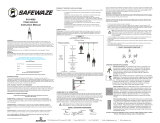 SafeWaze 018-4000 Owner's manual
SafeWaze 018-4000 Owner's manual
-
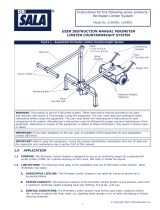 DBI/Sala Water Dispenser 2100090 User manual
DBI/Sala Water Dispenser 2100090 User manual
-
Klein Tools 87480 Operating instructions
-
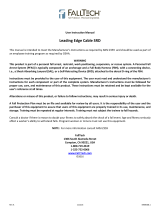 FallTech 727650LE User guide
FallTech 727650LE User guide
-
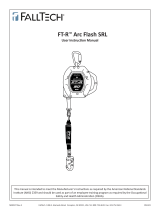 FallTech 721530TD1 User manual
FallTech 721530TD1 User manual
-
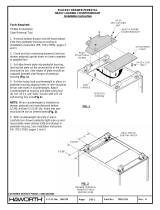 Haworth 7021-7111a Operating instructions
Haworth 7021-7111a Operating instructions
-
Kenwood 3-in-1 Owner's manual
-
Klein Tools 87920 Operating instructions
-
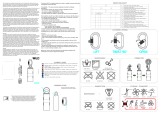 Kong WILO User manual
Kong WILO User manual
-
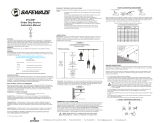 SafeWaze 019-4007 Owner's manual
SafeWaze 019-4007 Owner's manual










































